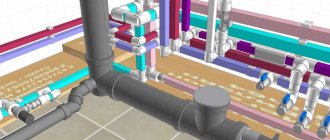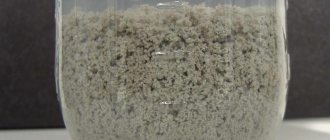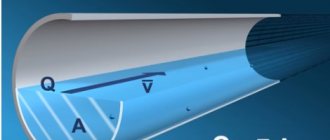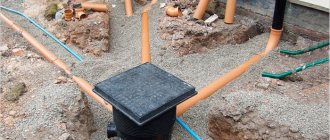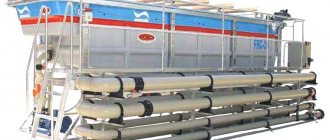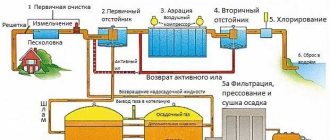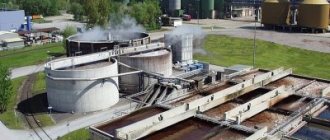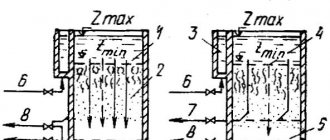What changed?
Experts call the amendments, additions and new control conditions large-scale and radical. The procedure for carrying out control measures and standards for the composition of wastewater have been supplemented with seven innovations:
- The frequency of scheduled control checks has been established - they should be carried out monthly, and not quarterly, as before.
- Visual control of wastewater has been introduced - inspection and verification of the presence of foreign materials, substances or waste in discharged waters. Their presence is checked without taking samples for analysis if they are visually noticed by a specialist. In order to determine the composition of wastewater, the water supply and utility organization must have special equipment.
- The use of automatic devices for conducting studies of collected water is regulated.
- The sampling conditions have been clarified.
- Specific methods and regulations for studying sampled wastewater are presented for specialists.
- The drains of transit organizations will be closely monitored. Control over wastewater systems not connected to the central sewerage main has also been tightened.
- The basis for wastewater control is explained in detail. Unscheduled inspections must be carried out in the following cases:
- emergency incidents;
- the threat of emergency situations in which permissible pollution standards are exceeded;
- lack of access for specialists from inspection bodies to wells.
Discharge of wastewater into the sewer system
All large populated areas are now provided with centralized sewerage systems. These engineering complexes include absolutely all the components that are necessary for collecting wastewater from a large number of facilities, transporting it to treatment facilities, separating mechanical, biological and chemical impurities, disinfecting and discharging into the environment. It should be noted, however, that the discharge and treatment of wastewater in such systems is not always organized in full compliance with the requirements of current environmental legislation and environmental standards.
Many centralized sewerage systems are outdated both physically and morally and require modernization. This work is successfully carried out by specialists. They have completed several very large-scale projects for the reconstruction of centralized sewer networks, which ensure the discharge of treated wastewater into the natural environment (reservoirs, landforms) in full compliance with the most modern environmental standards.
What do you need to know about wastewater composition standards?
The procedure for establishing standards for the composition of wastewater is regulated by Chapter XIII of the Rules. It specifies wastewater standards, an algorithm for monitoring compliance with standards, and a list of persons responsible for carrying out control activities.
- Standards for the composition of wastewater are established for pollutants for which the facilities of the corresponding water treatment plant have established standards for permissible discharges, as well as technological standards.
- The calculation of standards is entrusted to water supply and utility companies operating in the territory. For the accuracy of calculations, a special formula has been proposed, which is included in the contents of the document.
- Standards for the composition of wastewater are approved by municipalities or regional governments.
- Technologically regulated substances and elements have been installed for domestic and storm sewers.
Ecology DIRECTORY
Emergency releases are flammable gases and vapors entering the flare system when operating safety valves and other emergency release devices are released. [...]
Emergency monitoring is characterized by a hierarchical structure of goals. Firstly, it is necessary to select locations for the system elements that will ensure unconditional detection of emergency discharges into a water body. Next, it is necessary to determine such parameters of the elements of the monitoring system as threshold values and the accuracy of measuring instruments, the frequency of polling devices, etc. Finally, it is necessary to solve the problems of the functioning of the system, i.e., with its fixed parameters, determine the location of the emergency discharge, identify the composition of its constituents pollution, the power of the accident, its start time and duration. [...]
The discharge of polluted wastewater into the Black Sea is constantly growing. This is explained by the low pace of construction of water protection facilities, their ineffective operation, and emergency discharges.[...]
Emergency discharges of wastewater (to biological treatment facilities through city sewerage systems) - unexpectedly occurring as a result of emergency circumstances or intentional discharges with a high content of pollutants exceeding established standards. The result is a significant disruption of the functional state of activated sludge or its death, biological treatment is not provided, and damage is caused to the reservoir receiving wastewater. [...]
During emergency discharges, the acid concentration increases sharply. Its maximum possible amount exceeds 1 g/l.[...]
For emergency discharge of acids or alkalis at industrial enterprises, a receiving tank of appropriate capacity must be provided. Control of the pH value of wastewater discharged into the sewer system should be automated. [...]
For emergency discharge and emptying of the tailings dump, emergency releases are arranged on the water intake pipelines supplying clarified water to the circulating water pumping station; they are also used for flushing pipelines laid along the bottom of the tailings pond.[...]
In the event of an emergency release of large quantities of gas to a flare, personnel during equipment maintenance or evacuation should not be exposed to significant thermal radiation. To do this, it is necessary that the flare stack is high enough or, if this is not possible, protective measures must be taken.[...]
A large salvo (emergency) release of gas leads to an increase in pressure in pipeline 6. The gas pressure in pipeline 6 is transmitted through pipeline 18 under the membrane 17 of the membrane drive 16. The resulting force of the drive 16 balances the torque arising from the pressure on the valve 10 from the pipeline side 6 due to the eccentric position of the damper shaft. When the damper 10 is open, the main amount of gas is discharged onto the torch 9.[...]
To prevent emergency discharges of drilling waste into the sea and emergency oil spills, constant monitoring of the reliability of technical systems, training and advanced training of personnel are carried out. Emergency spill response plans have been developed based on probabilistic assessments of their occurrence and modeling of propagation processes in the marine environment. To eliminate the consequences of possible accidents, the forces and means of the Russian State Marine Rescue Service are currently involved.[...]
Taking into account the possibility of emergency discharge of petroleum products, we accept Hs.t = 1.0 m. [...]
Let n basic concentration options be calculated in advance using pollutant propagation models for all possible locations of emergency discharges and a sufficient number of variants of their parameters (volumes and moments of onset of discharges). Each such option has the form of a tabulated dependence Ci = Ci(Gl, Xq, Tq, X, T), i = 1, yr. Here, for each ith base case, Ci is the concentration of each of the pollutants taken into account, G1 is the volume of their discharges, Xq and Tq, respectively, are the location and initial time of the emergency release. These dependencies are plotted for various points X located downstream of Xq, and for different moments of time T > Tq. Any other emergency release option is determined by a linear combination of the conditions of these basic options. If monitoring has revealed certain data on jumps in pollutant concentrations, then the identification task, in comparison with the results of these calculations, should determine the possible locations and parameters of the emergency release. Thus, the identification task is the task of best approximation of parameters when describing the dependencies of the spread of pollutants to the measured monitoring indicators.[...]
The obtained indicators of the location of emergency discharges, the time of the onset of the accident, the power of the accident and the duration of the release must be subjected to statistical analysis. Since in simulation experiments these four quantities are played out separately, the probabilities of their correct restoration (reliability) must be found separately. It is also advisable to consider the probabilities of correct restoration of emergency discharges in the complex. In this case, only restoring the location of discharges is a discrete choice when the existing discharge structure that is responsible for the accident is correctly indicated, or a completely different structure is incorrectly indicated. The remaining quantities played out during imitation and then restored have continuous scales of change. Determining the probability of their correct choice (in comparison with the value played out during simulation) is associated with the introduction of a measure of their proximity. If the choice of the location of the accident is associated not with the choice of a specific discharge structure, but with the determination of the distance of the accident from some initial point on the river, then it is also necessary to analyze a continuous scale of comparisons of the played option and the chosen solution.[...]
In case of repair, an emergency discharge of wastewater into a reservoir from a coastal well is provided through an opening in this well or through a separate pipeline. A separate outlet pipeline usually ends at the shore or at a short distance from it. [...]
Let at the moment of time ¿о an emergency discharge of pollutants occur at the site bо with a flow rate of up to = £ /t during the period t. A wave of pollution went downstream with a speed V. The processes of pollutant diffusion are taken into account (propagating on both sides of the pollutant wave with a certain diffusion speed c/), as well as processes of decomposition, sorption and deposition of substances, characterized by the time of “half-purification” of water in the flow of contaminants. The crest of the wave corresponds to the duration of the discharge t. The left end of the wave, after some time from the moment the accident began, breaks away from the target and follows the river at the speed of the current. From this moment, the length of the wave crest is constant, but the wave then becomes more and more flat in accordance with the speed of the processes of decomposition, sorption and deposition of substances, until the concentration of pollutants in it becomes equal to the background concentration of the river flow. [...]
Sometimes overflow of sludge storage tanks leads to emergency discharges of contaminants. This was the case, for example, at the Stebnikovsky potash plant in 1984, where a sludge storage dam burst, containing 4.5 million m3 of concentrated technological liquid waste. The bulk of the sludge poured into the Dniester, causing significant pollution of the river and the death of fish. Residents of the cities of Odessa, Chisinau and other settlements were deprived of normal water supply for a long time.[...]
These “buffer” installations accept periodic refreshment discharges (with circular etching), emergency discharges, overflows from waste collectors and other variable flow rates of acid wastewater. [...]
Due to the specificity of individual workshop wastewater, before discharging it into the sewer, it is necessary to install workshop treatment facilities: in the acetylene production workshop - a settling tank to retain mineral sediment; in the acetaldehyde production workshop - a settling tank for catching heavy metals, an emergency tank for acidic water, equal to the volume of a one-time emergency discharge of contact acid; in the styrene production shop - a fuel separator and a styrene separator; in the polymerization shop - an emergency tank for catching latex and a settling tank for retaining rubber crumbs in the rubber production shop. [...]
When operating stations, there may be a need for emergency discharge of wastewater into a reservoir or rainwater network. For this purpose, an emergency release is arranged, the location of which is agreed upon with local councils and sanitary inspection authorities.[...]
All gas processing plants and refineries are equipped with flare units for burning emergency discharges of flammable gases and vapors after the activation of safety devices in both main and auxiliary equipment, as well as for process emissions during scheduled startups and shutdowns of equipment, burst emissions during testing of instrumentation and sampling devices.[ …]
One of the types of observations of environmental components is emergency monitoring of water quality in water bodies during burst emissions of pollutants. This section highlights the main components of the comprehensive goal of creating emergency monitoring, as well as mathematical models of operation and selection of its parameters. Ways to formalize emerging tasks are discussed, which together make it possible to resolve key issues about the implementation of the necessary measures to protect water bodies from emergency discharges of pollutants.[...]
In conclusion, it should be said that the neutralization of harmful substances during emergency discharges of waste gases from production and storage facilities occurs in flare installations.[...]
Particularly great damage to the environment is caused by accidents leading to volley emissions and discharges of pollutants into the natural environment, as well as fires. Emergency discharges, leading to a sharp increase in the intensity and danger of impact, pollute large spaces over short periods (significantly shorter than the period of self-healing of ecosystems). Fires associated with accidents are accompanied by the combustion of petroleum products at high temperatures and cause “stress blows” not only to water and soil and vegetation cover, but also to zoomicrocenoses.[...]
Elimination of overflows, spills, timely elimination of accidents, localization of emergency discharges, etc. also lead to a significant reduction in both the amount of wastewater discharged and its contamination. Particular attention in this regard should be paid to hydrometallurgical and sulfuric acid production.[...]
Wastewater from viscose production shops is very small in volume, but in case of emergency discharges of large quantities of viscose it poses a serious danger to the sewer network and the operating mode of treatment facilities.[...]
When choosing sites for pumping stations, you should also take into account the need for emergency wastewater discharges (in case of pump stoppage due to a power outage or for other reasons).[...]
Mathematical modeling of the possible spread of oil from an emergency release source located in the area of the Khvalynskaya, Shirotnaya, Sarmatskaya structures in the Caspian Sea was carried out. More than a thousand equally probable scenarios of weather conditions were considered, constructed according to the data of meteorological conditions for one complete “typical year”. Using the trajectory model, areas potentially vulnerable to an oil spill were identified.[...]
In the lower reaches - within the city of Ufa, water quality is affected by wastewater from enterprises: CHPP-2, DSK-KPD, as well as emergency discharges and discharges of pollutants from the territory of the northern industrial zone (Shugurovka River). [...]
Sewage systems must have at least two discharges into city sewer networks and devices for emergency discharge into a pit, trench or other device. [...]
When replacing hydrocarbon gas with nitrogen, the amount of harmful substances formed during a maximum emergency discharge does not decrease, but when the new flare unit operates in standby mode, the emission of harmful substances from the flare unit is reduced by 300 tons/year. [...]
The oil trap consists of four parallel working sections. Its inlet chamber is connected by a pipe with a diameter of 500 mm to an emergency pit 4 with a capacity of 1000 m3, designed to receive oil in the event of an emergency release from oil field reservoirs.[...]
Bacterial contamination of surface water bodies has increased sharply. This is largely due to the annually increasing number of emergency discharges of untreated wastewater, the extremely unsatisfactory condition of sewer collectors and the violation in most cases of the disinfection regime for wastewater discharged by public utility enterprises. [...]
From the table 3.21 shows that with constant combustion, the concentrations of harmful substances when burned in a new flare decrease by 115-125 times, and in the maximum emergency discharge mode - by 2-2.5 times. During an emergency release, the concentration of sulfur dioxide increases slightly. This is explained by the separate combustion of hydrogen sulfide (91.77% in hydrogen sulfide discharge) supplied to the auxiliary flare, and lower rates of hydrogen sulfide release from the mouth of the flare burner. [...]
The Ild River is a typical watercourse of the Yaroslavl Volga region from the category of the smallest - medium-small. Its total length is 46 km. In the middle reaches of the Ilda, it is influenced by emergency discharges from a cheese factory (from 2 to 4 times during the growing season). Two-year studies of the river were carried out during the entire period of open water. The diagram of the river and sampling stations is shown in Fig. 35. A total of 82 integral samples were analyzed. [...]
The influence of oil production enterprises on water resources is manifested mainly through the withdrawal of water for economic, industrial and technological needs and in 21 (1995) emergency discharges of petroleum products onto the terrain.[...]
If a simulation model of the functioning of a monitoring system with fixed parameters is considered, then emergency discharges of pollutants are artificially simulated in simulation experiments. During the experiments, the calculated concentrations of pollutants along the river are determined, including at the monitoring points. At the same time, problems of identification (detection and recovery) of accidents are solved. All recovery results are stored, after which they are statistically analyzed to calculate reliability. In practice, the reliability of monitoring is expressed by the probability of correct determination of a particular restored value. Therefore, the total number of simulation experiments (the number of simulated accidents) should be quite large (about 1000 or more).[...]
The solution to the identification problem is based on maximum likelihood or quadratic minimization methods combined with interpolation between different options for reset parameters. Let m be the numbering of monitoring device locations, t be the numbering of monitoring polling time points, s be the numbering of options for calculating the spread of pollution, i.e. the numbering of options for emergency discharge of pollutants. Let Crn(Xs, Tt) be the concentration of pollutants measured by the t-th monitoring device at point Xs at the moment Tt. Then the task of identifying an accident is reduced to finding such values of the accident power Gs, its location Xq and the start time Tg that the best agreement (in the sense of the minimum total square deviation) will be achieved between the concentrations measured by all monitoring devices and the concentrations calculated from pollution propagation models , i.e.[...]
Currently, aquatic ecosystems both on the globe in general and in the Urals, in particular, are subject to the simultaneous effects of various sources of radioactive contamination (global fallout, routine and emergency discharges of radioactive substances from nuclear fuel cycle enterprises, peaceful nuclear explosions and etc.). Therefore, one of the most important issues in radioecology is the problem of identifying sources of radioactive contamination of natural ecosystems.[...]
In conclusion, we will consider linearized methods for calculating the distribution of pollutants in a river network, which are intended not so much for direct calculations of the distribution of pollutants, but for estimating their concentrations in the problem of identifying emergency discharges (see below). The proposed formulas are based on the mass balance of pollutants at each moment of time of their propagation and allow one to quickly determine (with sufficient accuracy for initial assessments) the parameters of emergency discharge of pollutants. [...]
In the 90s State environmental control authorities examined 146,606 enterprises and organizations and found that 24,490 of them exceeded the emission standards of pollutants. There were also 1,840 cases of volley, emergency discharges of harmful substances, which resulted in billions of dollars in damage and harmed human health. [...]
A significant proportion of harmful substances enters the atmosphere when gas is burned in flares. In the practice of operating oil and gas complex facilities, flare systems are used: low pressure, which serve installations operating under pressure up to 0.2 MPa and high pressure - above 0.2 MPa; as well as local emergency installations that operate under low pressure, preventing the intake of gases into the gas tank. Flare units for burning substandard gas and gas-condensate mixtures generated during equipment operation or emergency discharges are presented in works [9-11]. Schematic diagrams for the discharge of gases and vapors are shown in Fig. 1.3, 1.4 [6].[ …]
One of the most dangerous consequences of the development of placer gold deposits is a significant increase in the turbidity of natural watercourses, leading to siltation of the riverbed and deterioration of the food supply of fishery facilities, as well as to persistent mercury pollution of bottom sediments of technogenic reservoirs. During emergency discharges of wastewater from such reservoirs or during flood destruction of dams and dams, a potential danger of mercury contamination of natural watercourses is created.[...]
Hydrogeological surveys. To obtain the necessary data on soils and groundwater, pits or wells (depending on the depth of penetration) are laid along the routes of collectors, networks and pressure water pipelines on average every 250-300 m along the length of the routes; additional penetrations are carried out in places of crossings of railways, rivers, ravines, outlets and emergency discharges; at the sites where pumping stations are located, 2-3 penetrations; on the territory of the treatment plant for the design assignment of 1-2 excavations per 1 hectare of area. [...]
Assessing damage from pollution of surface waters (rivers, lakes, ponds) with oil and petroleum products is a more complex task due to the lack of methods to date for calculating the area of pollution and the volume of polluted water for the pollution case under consideration. The existing recommendations are intended to assess damage from pollution from stationary sources of wastewater discharge. The effects of an emergency discharge of oil or petroleum products are of a pulsed nature and are characterized by a higher concentration of the ingredient. [...]
The third proposal - the elimination of storage ponds and the construction of communications for the preparation and injection of wastewater into productive horizons - initially turned out to be a very capital-intensive process. It was easier to pump this water through the existing ponds and pipes, using existing pumps, into the absorption horizon, into well 403. Otherwise that toxic wastewater seeped into the river or sometimes was forced, when the ponds overflowed, an emergency discharge was made into the trunk of a small river - this was considered a completely normal phenomenon in those years.[...]
An environmental audit is an independent study of all areas of an enterprise’s economic activity, conducted to determine the extent of its direct and indirect impact on the environment. Its objectives are to bring environmental activities into compliance with the requirements of legislation and regulations, optimize the use of natural resources, reduce energy consumption, reduce waste, prevent emergency discharges and man-made disasters. [...]
It is assumed that the composition of wastewater is constant, independent of time. For domestic wastewater, the constancy of the composition is more or less ensured, although deviations as a result of the discharge of shower water or the change of day and night cannot be excluded. The composition of industrial wastewater is very diverse. The types and amounts of pollutants in water can vary depending on the production technology, the number of operating workshops, the presence of emergency discharges, etc. Thus, the composition of wastewater, accepted for calculation as something unchanged, can actually change greatly. [...]
There are, however, many examples of groundwater pollution that has already occurred with industrial wastewater, in particular in areas where chemical, petrochemical, metallurgical and other “water-intensive” industries are concentrated. The flow of wastewater into groundwater here occurs mainly as a result of filtration from industrial pools - tailings and sludge storage facilities, storage tanks, evaporators, etc. The territories of industrial enterprises themselves also pose a great danger in this regard due to emergency discharges of wastewater and leaks of the latter from workshops and communications.[...]
Consequently, fish in the post-spawning period become most vulnerable to various types of adverse effects, including anthropogenic ones. This must be taken into account. It is possible that the observed cases of mass death of fish in the Rybinsk Reservoir immediately after spawning are a consequence of a significant decrease in the resistance of fish during this period of the year to damaging effects of the same force to which they were resistant in other periods. In particular, a massive death of blue salmon was observed immediately after spawning in the Sheksninsky reach of the Rybinsk Reservoir, which was most affected by the emergency discharge of wastewater from the Cherepovets Metallurgical Plant in January 1987, for 4 months. before spawning.[...]
An unfavorable environmental situation has developed in the Moscow region. The main source of air pollution in the capital is road transport, which accounts for 93% of the total emissions of stationary and mobile sources of pollution. A big problem in a city with a population of millions is industrial and household waste, of which 13 million tons are generated annually. Only 10-15% of industrial waste is processed, and 8% of household waste is incinerated. The rest are transported to the region, causing soil and water pollution. Local radiation anomalies have been discovered at almost all large landfills of solid household and industrial waste, which requires decontamination work. The influx of contaminated wastewater, as well as emergency discharges from enterprises, cause intense pollution of the region’s rivers. The most polluted rivers are the Moscow, Yauza, and Medvedka.[...]
How are fees for discharges in excess of standards calculated?
The issue of payment for the discharge of pollutants in wastewater is regulated by Chapter XV of the document.
- The amount of payments for discharges in excess of wastewater composition standards is based on the tariffs for payment for negative environmental impact, to which clarifying coefficients may be applied.
- Payment by all users of compensation for damage caused to the centralized sewerage system, if a specific culprit has not been identified.
The rules establish the amounts of fines for various types of violations. But there is no final version yet. The document continues to be updated with new information.
Discharge of waste and drainage waters as a type of water use right.
The greatest negative impact on the condition of water bodies compared to other types of water use is caused by the discharge of waste and drainage waters.
Water legislation considers the use of water bodies for the discharge of waste and drainage water, i.e., for wastewater disposal, as an independent type of water use right.
Drainage water
represent water, the removal of which is carried out by drainage structures for discharge into water bodies.
Wastewater
is rainwater, melted water, infiltration water, irrigation water, drainage water, wastewater from a centralized drainage system and other waters that are discharged (discharged) into water bodies after their use or drained from the drainage area.
Article 44 of the Water Code of the Russian Federation specifically defines the procedure for using water bodies for the discharge of waste and drainage waters: in compliance with the requirements stipulated by the Water Code of the Russian Federation and legislation in the field of environmental protection.
Prohibited
discharge of wastewater, including drainage, into water bodies: containing natural medicinal resources classified as specially protected water bodies. In addition, it is prohibited to discharge wastewater, including drainage, into water bodies located within the boundaries of the Western Zone of sources of drinking and domestic water supply; the first and second zones of sanitary (mountain sanitary) protection districts of medical and recreational areas and resorts; fishery protection zones, fishery protected areas. The discharge of wastewater, including drainage water, may be limited, suspended or prohibited on the grounds and in the manner established by federal laws.
According to Art. 56 of the Air Code of the Russian Federation, the discharge into water bodies of wastewater, the content of radioactive substances, pesticides, agrochemicals and other substances and compounds hazardous to human health exceeding the standards for permissible impact on water bodies, is prohibited. Unauthorized discharge of wastewater onto glaciers, snowfields, as well as pollution of glaciers, snowfields with production and consumption waste, pollution with petroleum products, pesticides and other harmful substances are prohibited (Article 58 of the Air Code of the Russian Federation).
When operating a water management system1, it is prohibited to: discharge wastewater into water bodies that has not undergone sanitary treatment or neutralization (based on the inadmissibility of exceeding the standards for permissible impact on water bodies and the standards for maximum permissible concentrations of harmful substances in water bodies); discharge into water bodies wastewater that contains pathogens of infectious diseases, as well as harmful substances for which MPC standards have not been established. Violation of the requirements for the use and protection of water bodies entails restriction, suspension or prohibition of the operation of water management systems (Article 60 of the Water Code of the Russian Federation).
Issues of water protection during the discharge of waste and drainage waters are reflected in schemes for the integrated use and protection of water bodies (Article 33 of the Water Code of the Russian Federation). The schemes establish, in particular, wastewater discharge limits,
meeting quality standards within the boundaries of river basins, sub-basins, water management areas under different water conditions;
quotas for the discharge of wastewater
that meet quality standards within the boundaries of river basins, sub-basins, water management areas under various water conditions in relation to each constituent entity of the Russian Federation.
The procedure for carrying out this type of water use is also regulated by the Federal Law of December 7, 2011 No. 416-FZ “On Water Supply and Water Disposal”, the Rules for Cold Water Supply and Water Disposal approved by Decree of the Government of the Russian Federation of July 29, 2013 No. 644, and other regulatory legal acts .
- Water management system is a complex of water bodies and hydraulic structures intended to ensure the rational use and protection of water resources.
- NW RF. 2011. No. 50. Art. 7358.
- NW RF. 2013. No. 32. Art. 4306.
Purpose of innovation
The purpose of amending the Water Supply and Sanitation Rules 2021 is to improve the environmental situation.
Thus, according to Federal legislation, users who exceeded the discharge standard for the same pollutant more than twice during the year, or exceeded this standard once by 3 times, must develop a program, the implementation of which will reduce harmful discharges. The cost of doing so will be deducted from their payment for excess discharges.
We recommend
Water supply and sanitation in 2021. New environmental standards and requirements. Wastewater control. Seminar in Moscow + Online broadcast
Practicing experts will give recommendations on reducing and preventing antimonopoly risks, preparing for obtaining a comprehensive environmental permit in 2021, rules for establishing temporarily permitted discharges, calculating payments for the negative impact on the central heating system, implementing measures to reduce discharges in order to reduce subscription fees, and other topical issues in the field of water supply and sanitation in 2021.
Methods of wastewater disposal
Almost any treatment plant can be characterized as walk-through. This means that the runoff passes through them, undergoes some changes and is then discharged. There may be several options for diversion.
1) To a higher level sewer. As a rule, this is relevant for facilities equipped with local treatment systems and located in populated areas with centralized sewerage.
2) Into circulating water supply. Although technically wastewater can be brought to the quality of drinking and even highly purified, in non-arid countries such deep processing of household wastewater is usually impractical, especially for the purpose of drinking water supply. The exception is many industrial enterprises, for various reasons. It is worth noting that a very small proportion of enterprises with recycled water supply have a completely closed cycle; Usually, some of the wastewater is still discharged outside.
3) Into the environment - a body of water, on the ground or underground, into the atmosphere.
Obviously, in the first case, the procedure for receiving wastewater must be discussed with the owner and/or operator of the central sewer system. In the second case, discharge into the circulating water supply is regulated within the economic entity. Therefore, let us examine in more detail the third method, which is the most relevant for readers of our site and affects the interests of the widest circle of the public.
To begin with, it is worth pointing out that methods for disposing of treated wastewater into the atmosphere or underground are quite rare and highly specialized. For example, evaporation plants, evaporation ponds, and gas flares have limited use. But they require either large free territories or access to cheap sources of heat or energy, and are also limited in the volume of disposal and climatic conditions. Disposal of wastewater into deep underground wells is used in the mining industry, but also has a number of limitations and is poorly applicable in the case of domestic wastewater from settlements.

